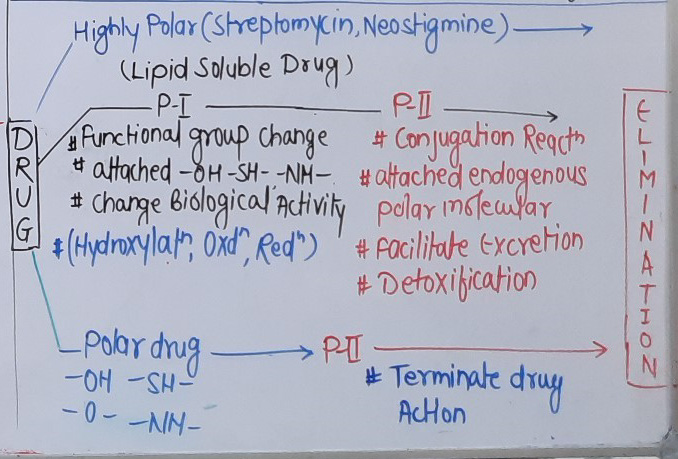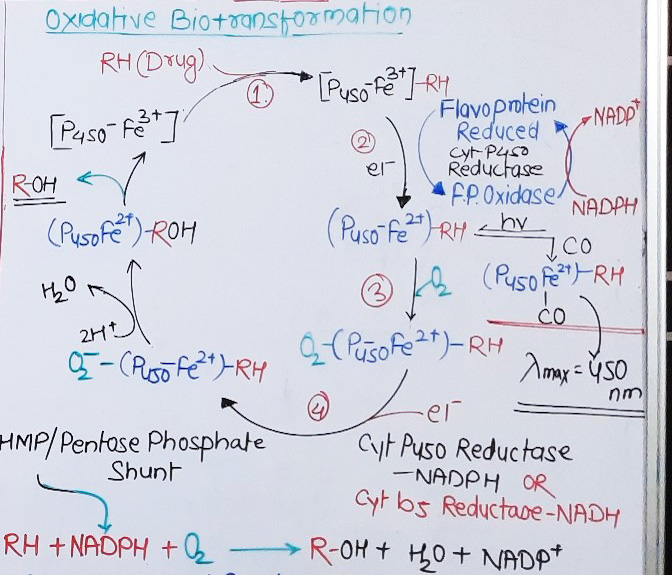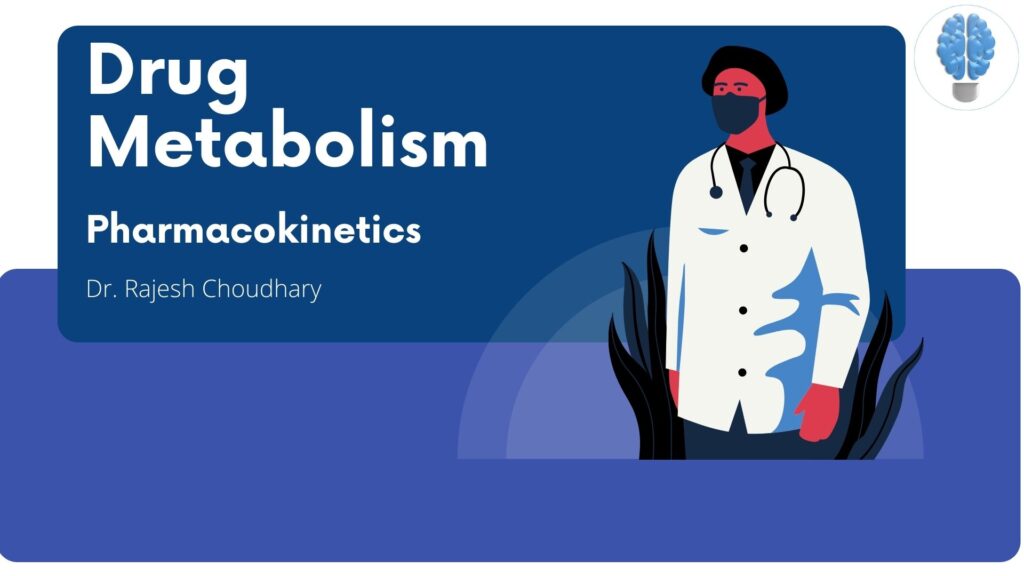Drug Metabolism
Drug Metabolism is also known as Biotransformation. Bio-Chemical alteration of drugs or xenobiotics within the biological system is known as Biotransformation. The liver is the major organ for drug metabolism, others are the intestine, blood, lungs, kidney, placenta, etc. The process of alterations in the drug structure by the enzymes in the body is called “biotransformation (drug metabolism)” and the products form after these reactions are called “drug metabolites”.
The main purpose of drug metabolism is to eliminate. The metabolites that are formed after biotransformation are generally more polar, more easily ionized compounds compared to the main (original) drug. So, these metabolites can be excreted from the body easily. Besides this, conversion of drug metabolite may result into:
- Drug Activation
- Drug Inactivation
- Toxic metabolite
- Biological activity alteration
Some important features are:
1. Drug Activation
Some drugs which don’t have any activity in vitro may gain activity after their biotransformation in the body. These types of drugs are called “pro-drug” or “inactive precursor”.
- Drug examples that gain activity after biotransformation (pro-drugs):
PRO-DRUG | EFFECTIVE METABOLITE |
Chloral hydrate | Trichloroethanol |
Cortisone | Hydrocortisone |
Enalapril | Enalaprilate |
Lovastatin | Lovastatin acid |
Clofibrate | Clofibric acid |
L-DOPA | Dopamine |
- Drug examples that are transformed to more active compounds after biotransformation:
DRUG | MORE ACTIVE METABOLITE |
Imipramine | Desmethylimipramine |
Codeine | Morphine |
Nitroglycerin | Nitric oxide |
Losartan | EXP 3174 (5-carboxylic acid metabolite) |
Thioridazine | Mesoridazine |
2. Drug Inactivation
- Drug examples that are transformed to less active compounds after biotransformation
DRUG | LESS ACTIVE METABOLITE |
Aspirin | Salicylic acid |
Meperidine | Normeperidine |
Lidocaine | De-ethyl lidocaine (dealkylated) |
- Drug examples that are transformed to inactive metabolites after biotransformation
DRUG | INACTIVE METABOLITE |
Most of the drugs | Conjugated compounds |
Ester drugs | Hydrolytic products |
Barbiturates | Oxidation products |
ENZYMATIC DRUG METABOLISM
Drug metabolizing enzyme pathways generally mediate 2 types of reactions:
- Phase I reactions
- oxidation-reduction and hydrolysis
- introduce or unmask polar chemical groups, therefore, increase water solubility
- mediated by cytochrome P450 enzymes
- P450’s are found in the endoplasmic reticulum or cell cytoplasm
- Phase II reactions
- conjugation with polar endogenous substrates e.g. glucuronic acid, glutathione, etc
- increases water solubility and renal elimination
Basic Features:
- Highly water-soluble drugs excrete unchanged.
- Lipid soluble drugs go to Phase I and Phase II
- The drugs having –NH2, -SH, or –OH groups are directly going to Phase II.

Figure 1: Basic features of drug metabolism
PHASE 1 REACTION OF DRUG METABOLISM
1. Oxidative Reaction
- Oxidation reactions are performed mostly by the enzymes in the liver (hepatocytes) which are localized in the endoplasmic reticulum in microsomal fractions.
- These enzymes are cytochrome P450 mixed-functional oxidases. P= pink, 450 = absorbance wavelength λ (450 nm)
- For the oxidation reactions, also molecular oxygen (O2) and NADPH (generate from pentose phosphate shunt) are required.
- Some special characteristics of the microsomal P450 enzyme system:
- They are located in hepatic microsomes.
- The substrate specificity is low.
- Shows high affinity to high lipophilic molecules.
- NADPH and molecular oxygen (O2) are required for its activity.
- Metabolic poison inhibits the CyP 450 dependent metabolism
- Cytochrome P450 is a “hem” containing protein.
- The active site of the protein is the Fe ion. This active site can bind the drug only if the Fe is oxidized in the form of Fe+3.
- After the formation of the enzyme-drug complex, an electron (e–) released from NADPH by the enzyme NADPH-cytochrome P450 reductase is transferred to this complex.
- Reducted enzyme-drug complex binds molecular O2.
- Following this binding, the enzyme-drug-O2 complex breaks down into oxidized enzyme (oxidized free cytochrome P 450), water (H2O) and oxidized drug.
RH + O2 + NADPH2 à ROH + H2O + NADP+

Figure 2: Oxidative reactions pathway
Cytochrome P450 enzyme
- Cytochrome P450 enzyme is not an enzyme with only one type.
- P450 1, 2 and 3 (CYP1, CYP2 and CYP3) genes are involved in coding the enzymes which are responsible for the drug metabolism.
- Especially CYP3 type codes the enzymes that are responsible for the pre-systemic elimination of orally administered drugs
Enzyme | Drug examples |
CYP3A4 | Most of the drugs |
CYP1A2 | Caffeine, theophylline, paracetamol, propranolol… **Activation of Protooncogenes |
CYP2C9 | Phenytoin, oral antidiabetics, NSAIDs… |
CYP2C19 | Diazepam, propranolol, omeprazole… |
CYP2D6 | Beta-blockers, some antidepressants, nicotine, opioid analgesics… |
CYP2E1 | Chronic alcoholism induces this enzyme |
2. Reduction Reaction
- These reactions are seen in fewer amounts compared to oxidation reactions.
- FAD is required additional to NADPH for these reactions.
Aldehyde reduction | Transformation to alcohol | Cytoplasmic flavin containing enzymes |
Azo (N=N) reduction | Transformation to amines | Microsomal flavin containing enzymes |
Nitro reduction | Transformation to amine or hydroxilamine | Microsomal and cytoplasmic flavin containing enzymes |
3. Hydrolysis
A group is separated from the drug molecule, or a drug molecule is broken down into two smaller molecules. Some examples are:
Esterase (hydrolysis) reactions | S-dealkylation |
Decarboxylation | Acetylcholine esterase, pseudo choline esterase, amidase |
Glycoside hydrolysis | Decarboxylases |
O-dealkylation | β-glycosidases |
N-dealkylation |

Figure 3: Oxidative drug metabolism
PHASE 2 REACTION OF DRUG METABOLISM
- Glucuronidation
- UDP-glucuronosyltransferases catalyze the reaction.
- This is a microsomal enzyme located in the endoplasmic reticulum of liver cells.
- Glucuronidation is the only conjugation reaction performed by microsomal enzymes. All the other conjugation reactions are performed by non-microsomal enzymes.
- Drugs like chloramphenicol, salicylic acid, morphine, and endogenous compounds like steroids and bilirubin are conjugated with glucuronic acid. Glucuronic acid is a highly hydrophilic compound, so it decreases the lipid solubility of the drug after conjugation. Thus, excretion of the drug becomes easier
Other phases 2 reactions are:
- N-methylation
- O-methylation
- N-acetylation
- Sulfate conjugation (sulfation)
- Glutathione conjugation
- Conjugation with amino acids
- Conjugation with ribose or ribose phosphates
Type of Conjugation | Endogenous Reactant | Transferase (Location) | Types of Substrates | Examples |
Glucuronidation | UDP glucuronic acid | UDP glucuronosyl-transferase (microsomes) | Phenols, alcohols, carboxylic acids, hydroxylamines, sulfonamides | Nitrophenol, morphine, acetaminophen, diazepam, N-hydroxydapsone, sulfathiazole, meprobamate, digitoxin, digoxin |
Acetylation | Acetyl-CoA | N-Acetyltransferase (cytosol) | Amines | Sulfonamides, isoniazid, clonazepam, dapsone, mescaline |
Glutathione conjugation | Glutathione (GSH) | GSH-S-transferase (cytosol, microsomes) | Epoxides, arene oxides, nitro groups, hydroxylamines | Acetminphen, ethacrynic acid, bromobenzene |
Glycine conjugation | Glycine | Acyl-CoA glycinetransferase (mitochondria) | Acyl-CoA derivatives of carboxylic acids | Salicylic acid, benzoic acid, nicotinic acid, cinnamic acid, cholic acid, deoxycholic acid |
Sulfation | Phosphoadenosyl phosphosulfate | Sulfotransferase (cytosol) | Phenols, alcohols, aromatic amines | Estrone, aniline, phenol, 3-hydroxy-coumarin, acetaminophen, methyldopa |
Methylation | S-Adenosyl-methionine | Transmethylases (cytosol) | Catecholamines, phenols, amines | Dopamine, epinephrine, pyridine, histamine, thiouracil |
Water conjugation | Water | Epoxide hydrolase (microsomes) | Arene oxides, cis-disubstituted and monosubstituted oxiranes | Benzopyrene 7,8-epoxide, styrene 1,2-oxide, carbamazepine epoxide |
(cytosol) | Alkene oxides, fatty acid epoxides | Leukotriene A4 |
FACTORS THAT AFFECT THE BIOTRANSFORMATION OF DRUGS
- Induction or inhibition of microsomal enzymes
- Genetic differences
- Age
- Gender
- Liver diseases
- Environmental factors
- Induction or inhibition of microsomal enzymes
- Various drugs or environmental factors lead to increases in the activity of these enzymes by increasing the synthesis of microsomal enzymes.
- The importance of enzyme induction is the increased metabolism rate of the drugs and the reduction in their activities.
- On the other hand, some drugs stimulate the enzymes that inhibit themselves (biochemical tolerance).
- E.g., INDUCER (P C BAR PG)= Phenytoin, Carbamezapine, Barbiturates, Alcohal, Rifampicin, Phenylbutazone, Griseofulvin.
- Unlike enzyme induction, some drugs can inhibit microsomal enzymes.
- INHIBITOR (COKE PI) = Cemitidine, Omeprazole, Ketakonazole, Erythromycin, Protease Inhibitor (Saquinavir), INH.
- **Enz. Inducers enhance the elimination and reduce the therapeutic efficacy.
- *** Enz inhibitors decrease the elimination and increase the toxic effects.
- SOME CLINICAL RELAVANCE
- erythromycin inhibits the CYP3A4 enzyme and predisposes to cisapride toxicity and possible fatality
- cimetidine inhibits P450 enzymes, leading to increased levels of theophylline, diazepam, warfarin, phenytoin
- phenobarbital induces P450 enzymes, which could decrease levels of other drugs
- (see below: Enzyme Induction)
- the SSRIs could inhibit CYP 2D6 (and 3A4), and therefore increase serum levels of other drugs metabolized by these enzymes, e.g. benzodiazepines, carbamazepine, phenytoin
- the new HIV drugs, the protease inhibitors, are metabolized by cytochrome P450 enzymes, (e.g. indinavir is metabolized by CYP 3A4), and hence could interact with other drugs metabolized by this route
- Genetic differences
- Genetic polymorphism in some of the enzymes that play role in the biotransformation of drugs can cause changes in the activity of the drugs which are metabolized by these enzymes.
- Hydrolysis of succinylcholine: Cholinesterase enzyme (BuChE) in plasma play important role in the hydrolysis of succinylcholine which is generally used for its muscle relaxant activity.
- The metabolism of succinylcholine slows down in individuals who have atypical cholinesterase, Enz. And the further activity of succinylcholine can rise up to hours in individuals who have atypical cholinesterase enzyme (long duration (prolonged) succinylcholine apnea).
- Acetylation of isoniazid:
- Some individuals can metabolize this drug slowly (slow acetylators) and some faster (rapid acetylators).
- CYP2D6 polymorphism:
- CYP2D6 enzyme plays important role in the metabolism of many widely used drugs.
- This polymorphism can be also named “debrisoquine type polymorphism”.
- The metabolism rate of some beta-blockers (metoprolol, timolol), some neuroleptics (thioridazine, perphenazine), and antitussives like dextromethorphan or codeine decrease significantly in the slow metabolizers.
- Age and Gender
- In newborns, cytochrome P450 enzymes and glucuronosyltransferases are not sufficient.
- So, the biotransformation of some drugs (diazepam, digoxin, acetaminophen, theophylline, etc) is very slow in newborns.
- Oxidation reactions performed by the cytochrome P450 enzyme system are slower than normal metabolizing rates in the elderly.
- The effect of aging on these enzymes can differ according to gender (reduction in enzyme activity is higher in old males) and between individuals.
- First-pass elimination shows a reduction with age as well.
- Metabolism rates of some drugs may change with gender. For example, succinylcholine and other choline esters and procaine are inactivated faster in men.
- Liver Disease
- Especially, the metabolism of drugs with a “high hepatic clearance” decreases in liver diseases.
- This leads to accumulation of drugs in the body which are metabolized in liver, and eventually causes an increase in the effect and adverse effects as well.
- On the other hand, transformation of pro-drugs into their active forms occurs less in liver diseases.
- Environmental factors
- Especially pollutants can affect the microsomal enzymes.
- Induction of microsomal enzymes can occur with:
- Biphenylles with polychlor
- DDT and some insecticides
- Benzopyrenes and other polycyclic aromatic hydrocarbons (products of burned coal and petroleum products)
- Polycyclic hydrocarbons in the cigarette smoke can induce some enzymes like CYP1A2 and CYP1A1 (For this reason, the metabolism rate of chlorpromazine, theophylline and imipramine is significantly high in heavy smokers).
- Diet (Cabbage and cauliflower can induce CYP1A1 and CYP1A2)
- Inhibition of microsomal enzymes can occur with;
- Carbon monoxide inhibits the microsomal enzymes.
- Grapefruit juice (some flavonoids in grapefruit juice can inhibit CYP3A4)

